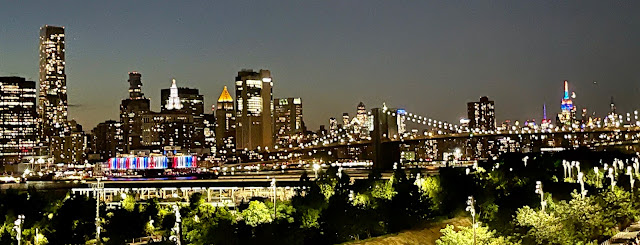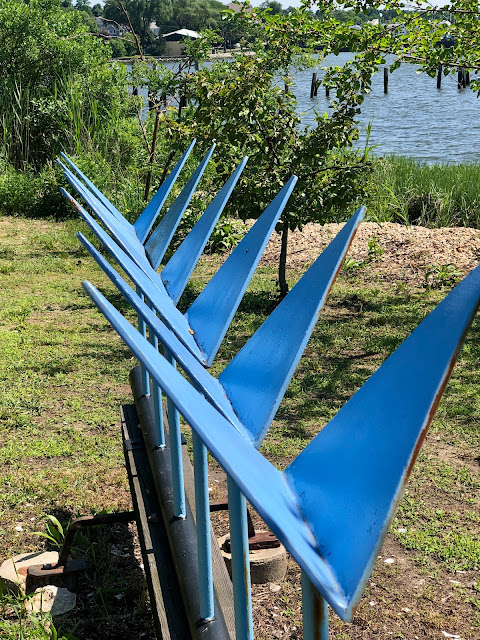Susan and Rob, after a long wait for luggage at JFK and adventuresome bus rides through non-tourist parts of New York City, finally joined us on Mantra around 6:30 p.m. As we were pitching and yawing on the dock at One 15 Brooklyn Marina, we chose to walk to Montegue Street for dinner. We found a fantastic Italian restaurant, Felice, and enjoyed excellent food and wine in a lovely room. After dinner, we walked a block towards the East River to admire the views from the Brooklyn Promenade. To and from the marina, we also appreciated the architecture of the townhouses on either side of tree-lined streets.
 |
| View of Lower Manhattan and the Brooklyn Bridge from the Brooklyn Promenade |
 |
| Peter, Susan, Rob and Sherri at Felice Restaurant |
Back on Mantra, it is possible that the rocking helped us to sleep, although we were all pretty tired. I read for a while and marveled at the cacaphony of sound from the city--endless layers of types and tones and pitches--rumbling, chattering, buzzing, droning reverberations from every direction--accompanied by the closer thwacks of dock lines slapping on hulls as the floating docks and vessels jostled about.
 |
| Mantra with Lower Manhattan across the East River |
Rob was up early and enjoyed running along the paths of Brooklyn Bridge Park. By the time he returned, we were all awake, so we had breakfast in the cockpit, admiring the views from deck before casting off from the dock at 9 a.m. to head up the East River to Long Island Sound. The views of Manhattan from the river are spectacular, and the current contributed about three knots to our speed. Hell's Gate, a narrowing of the channel in the middle of the strait, posed no problems at all and we were quickly into Long Island Sound.
We headed into Manhasset Bay, a large harbor with a winding, tree-lined shoreline. On the western shore, we could see various mansions, some dating from the Gilded Age. We picked up a mooring ball near the town of Port Washington, launched the dinghy and headed to town. From the dinghy dock across the street from the Shop and Save (convenient for provisioning, which we did not need to do), we walked south along Bay Walk Park by the waterfront. We were hungry, so we didn't stop on the way to read the many signs explaining the history of the area and the works of art along the path, although we did take the time to admire the plants, most of which were native flora.
 |
| Susan, Rob and Peter on the waterfront in Port Washington |
The downtown area was small and not very lively, but we fortuitously chose a deli, Ayhan's Mediterranean Marketplace, where we were overwhelmed by the array of tempting foods and had a hard time deciding on our choices. There was a lovely seating area with breezes coming in off the water, and we relaxed as we enjoyed another delectable meal. After lunch, we visited a couple of the small shops on Main Street and then headed back to the dinghy. Along the way, my appetite sated, I stopped to read all the signage and admire the many works of arts with local themes by local artists which are part of the outdoor Nautical Art Museum.
 |
| Art work representing the contributions of immigrants to the sand mining industry |
 |
| Stained glass piece recognizing the history of yachting and sailing in Manhasset Bay |
 |
| Sculpture alluding to the development of air travel in the area |
 |
| Art work commemorating the first transatlantic passenger flight from the U.S. in 1939 |
 |
| Mosaic depicting sailing on the bay |
The signs besides the works of art revealed fascinating history of the area. First settled by European colonists in 1644, in the 1870s, it became a major sand mining area. It had the largest sandbank east of the Mississippi River and easy barge transport to New York City. Over the following decades, the sand was used for concrete for the construction of skyscrapers such as the Empire State Building and the Chrysler Building and the New York subway system.
In the 1930s, Port Washington was the New York base for Pan-American Airlines, with destinations including London, the Azores and Bermuda.
A mecca for wealthy New Yorkers since the 1800s, the area around Manhasset Bay is associated with many well-known individuals and families who built their holiday homes here, including Daniel Guggenheim, a mining magnate and philanthropist who promoted aviation in the area; the newspaper publisher William Randolph Hearst Sr.; Frank Costello, an Italian-American crime boss of the Luciano family; and the publisher Condé Nast. There have been or still are famous artists, musicians, writers, film and stage stars and producers and politicians residing in or having links to the area. Manhasset Bay is also known as the setting for F. Scott Fitzgerald's The Great Gatsby. The wealth and social life depicted in this classic novel reflect the reality of the place during the Roaring 20s in Manhasset Bay.
By 4 pm., we were back on Mantra. The wind has shifted since we moored and now there is a cool breeze from the south which is refreshing in the hot sunshine of the late afternoon.
No comments:
Post a Comment